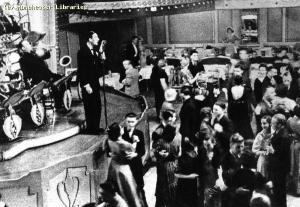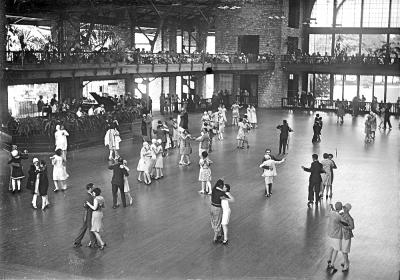- Jazz Age Manners
- Cutting In to the Dance in the Jazz Age
- Dance Etiquette - 1926
- Same-Sex Social Dancing in the Jazz Age
- Shocking Fashion Trends in 1920 or The Adventures of Minnie Fewclothes
- Social Dancing and the Art of Conversation
- Some Thoughts on Men and Clothes at a Jazz Age Event
- The Wearing (or not Wearing) of Gloves in the Jazz Age
- Where People Danced in the Jazz Age
Where People Danced in the Jazz Age
In getting a sense of the dances of the Jazz Age, it's helpful to also get a feeling for where people were dancing.
In short, almost everyone danced and they danced almost everywhere. Many public events had provisions for dancing, and there were frequent private dances of all descriptions. They covered the whole gamut of social class and ethnicity, and were as formal or informal as was the habit within that group: though nearly everyone, rich or poor, black, white or brown, would at least wear dresses, coats and ties to go out in public and dance, even if they weren't part of a socioeconomic group that could afford "evening dress".
 Colleges and high schools had frequent dances. Clubs (especially "country clubs") and other private organizations like fraternal organizations (Masons, Elks, Grange, VFW, Woman's Clubs etc.) threw frequent dances for their constituencies. Hosting a dance seemed to be a prime way for a group to affirm its identity.
Colleges and high schools had frequent dances. Clubs (especially "country clubs") and other private organizations like fraternal organizations (Masons, Elks, Grange, VFW, Woman's Clubs etc.) threw frequent dances for their constituencies. Hosting a dance seemed to be a prime way for a group to affirm its identity.
I recently reviewed the old company newsletters of my corporate employer, and was struck by how many formal dinner dances they threw back in the '50s and early '60s for their employees and their families, because when men and women got together, they danced.
Private functions of all types (dinner parties, charity galas, weddings, picnics) frequently included planned or spontaneous dancing, since dancing was enthusiastically pursued in every social class and, with the exception of those who had a religious scruple against it, every element of society. Music could be live (professional or performed by the guests) or provided by a gramophone or radio.
As to the public dance scene: the following categorization of public dance venues is based upon a list in "The Taxi Dance Hall: A Sociological Study in Commercialized Recreation & City Life" by Paul Goalby Cressey, 1932. He is describing the dance scene in Chicago in the early '30s, just before the repeal of Prohibition.
Private events such as those listed above would be as segregated as the groups that staged them. Public events, at least in Chicago, with the exception of the "black and tan" clubs and dance pavilions, were usually segregated in a way that excluded African Americans but let pretty much anyone else in. Filipinos, Chinese, Mexicans etc. were all sufficiently "white" in the Windy City to be admitted to most main stream establishments.
Beyond overt racism, these venues would be segregated by class through the simple fact of expense. Night clubs and classy restaurants would tend to cater to a more upscale clientele not because they wouldn't let poor people in, but because poor people couldn't afford their prices or the quality of clothes required to fit in. The better off, however, would occasionally go slumming to venues open to the working class, and young, well-to-do men were especially mobile.
Even though Prohibition was in force when he wrote this, he makes no reference to "Speakeasies" and seems to regard the consumption of alcohol as widespread and not worthy of particular note. It seems likely that former speakeasies, in a town where Prohibition had so clearly failed, had morphed into the "Night Club" and "Road House" categories.
Here is his break down of the types of publicly available dance options:
1. Municipal Ballroom or Pavilion: Owned and operated by the city as a public benefit. Low cost, simple furnishings.
2. Dancing Academy: Operated as a private enterprise by professional teachers with an organized course of instruction. All ages attended and the fees were relatively high. Many Taxi-dance halls called themselves "Dance Academies" and their girls "Teachers", but clearly it was a very thin cover for something quite unlike a dancing school.
3. Social Service Dance: Operated for altruistic reasons by a charitable organization for the benefit of the people the organization was trying to help - who were probably the dancers as well. Costs were relatively low.
4. Fraternal or "Benevolent" dance: Organized by a fraternal organization, club or church for the benefit of its members and/or to raise money for a good cause.
5. Pseudo-club dance: A dance put on by a club or loose affiliation (e.g. "The Jolly Steppers") that was basically a subscription ball open to anyone with the price of a ticket.
 6. Hotel Dance: A regularly occurring dance given by a hotel for its guests and those they invited. Admission was generally free and the attendees mirrored the clientele of the hotel. Hotels also hosted dances of type "7" and "8" in their restaurants and club facilities (such as the Cocoanut Grove in the Los Angeles Ambassador Hotel)
6. Hotel Dance: A regularly occurring dance given by a hotel for its guests and those they invited. Admission was generally free and the attendees mirrored the clientele of the hotel. Hotels also hosted dances of type "7" and "8" in their restaurants and club facilities (such as the Cocoanut Grove in the Los Angeles Ambassador Hotel)
7. Dine-and-Dance Restaurant: A dance floor and band was provided incidental to the food and drink being served. There may or may not have been a cover charge, but it would be expensive either way. They had a heterogeneous clientele who didn't mix much with guests outside their familiar social circle.
8. Cabaret or "Night-Club": Differed from a Dine-and-Dance restaurant in the presence of vaudeville style acts (chorus girls, acrobats, comedians, contortionists, exhibition dancers etc.) Guests alternated between dining, dancing and watching the show. Generally a rather expensive evening. Night clubs might be well-appointed, upscale restaurants or be less well appointed and found in questionable parts of town - though they could still cater to an upscale crowd. These included the "Black-and-Tan" clubs which catered to a racially mixed clientele. (For Hollywood depictions of quirky, themed night clubs, you can't beat the places frequented by Nick & Nora Charles in the "Thin Man" movies).
9. Dance Palace: A large well-appointed, privately owned facility which staged public dances - like the Avalon Casino Ballroom in Catalina. Dancing was the primary focus with food and other refreshments purely secondary. The clientele was heterogeneous. Prices could be comparatively high.
10. Dance Pavilion: A lightly built, simply furnished facility associated with places like amusement parks and fairs. Dances were seasonal and inexpensive and available to all social classes and frequently all races.
11. Road House: A facility outside the major cities which provided, in addition to to food and drink, music, dancing and possibly vaudeville entertainments. The quality of the place, the clientele and the prices could vary widely.
12. Rent Party: Especially in black communities a place for a semi-public social dance within the cramped confines of a private home. Guests made a donation to the host to help him meet the rent.
13. Pleasure Boat Dances: Excursion boats offered this as an additional feature. The Catalina Island ferries used to do this.
14. Dance Halls: These were the focus of the author's work, and he made the distinction between those which allowed women to pay a fee and enter (escorted or not) and those which were "closed" and only allowed male guests, who would then dance with the taxi-dancers, usually at "a dime a throw". Both types were in the less desirable parts of town and catered to the working class - though as with houses of prostitution, men of all social classes could be seen in such establishments.
Of all of these options, I think the taxi dance hall has the most to say about the place of dancing in Jazz Age society.
Lonely men of every age, class and ethnicity were paying women to dance an anonymous Foxtrot with them. The idea would just sound bizarre today, but in the Jazz Age, dancing was central to the way men and women connected with each other and to them, it made perfect sense.
